| bc |
Story papers, the British
weekly reading format for boys and girls back in the arly
20th century.
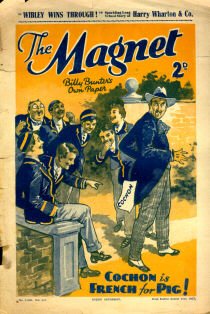
|
|
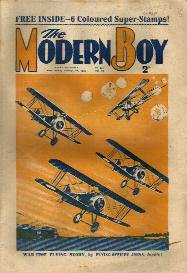 |
According to Bill
Lofts' and Derek Adley's OLD BOYS BOOKS: A
COMPLETE CATALOGUE (1969, privately printed,
later re-published by Howard Baker, London) the first
juvenile paper to appear was most likely 'The
Young Gentleman's Magazine', published by G
Kearsly, Fleet Street, London in 1777. Copies of this
paper are said to exist in Yale University. (Confirmation
on this point would be appreciated.) The first popular
juvenile publication to appear on a weekly basis in
England was 'The Boys' and Girls' Penny Magazine'.
This appeared in September, 1832 and consisted of 8
pages, the numbers of which began the tradition of
running continuously, enabling an index to be bound in
with multiple issues. At least 23 issues appeared. The
cover was mostly taken up by an illustration and the main
story was usually a fairy tale. According to our two
intrepid investigators mentioned above, issue 21
contained the following remarkable statement: "The
Christmas sale of this periodical was...a grand total in
figures of 835,000 copies being sold in one week."
Other similar publications soon
followed, encourage no doubt by the above statement,
whether it was fact or fiction. The first so-called
'penny dreadful' appeared in 1866 - Charles Stephens' 'Boys
of England'. It was indeed priced at one penny
(1d) and the fiction was of a simplistic nature, each
paragraph consisting of no more than two sentences.
Hundreds of writers were required at the turn of the
century to keep all these papers going. Penny dreadful
papers died out by the turn of the century and were
replaced by the modern types of story papers, the first
being the 'Halfpenny Marvel', published
by Alfred Harmsworth, in 1893. This ran for 533 issues,
became the 'Marvel' in 1904, ran for a further 952 issues
before being absorbed into 'Sport and Adventure'
in 1922. 'Union Jack' and 'Pluck'
appeared in 1894. Other publishers involved in the
publication of Story Papers included Aldine, Pearson's,
James Henderson and Trapps Holmes, before the Amalgamated
Press cornered the market in the 1920s. The Scottish firm
D C Thomson managed to keep five papers going as well,
there being such a wide demand in the years following WWI
for cheap juvenile literature.
With the arrival of WW2, paper
shortages helped kill off most of the weekly story
papers, as did the loss of staff to the armed services.
TV and American comics arrived in Britain after the war
and helped finish off the newer papers such as EAGLE,
BOY'S WORLD, RANGER and GIRL'S CRYSTAL. Many generations
of readers learnt how to cope with life through what they
read in these papers and they hold a continuing
fascination for collectors of juvenile literature.
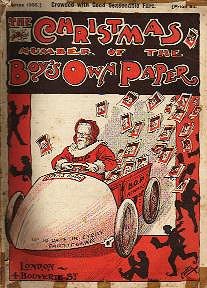
The Christmas, 1906 number of
The Boy's Own Paper (BOP) |
SOME NOTABLE
WEEKLY BRITISH STORY PAPERS
Boys Own Paper, The 1979 - 1967 1767 issues, RTS
(Religious Tract Society)
Boys
World 1963 - 1964 89
issues, Longacre Press
Bullseye 1931 - 1934, 183 issues,
Amalgamated Press (AP)
Champion 1922 - 1955, 1729 issues,
Chums 1892 - 1932 2077 Cassells, then AP
Crystal/Girls
Crystal 1935 - 1963
1400 plus issues, AP
Detective
Weekly 1933 - 1940 379
issues, AP
Gem,
The 1907 - 1939 1711
issues, AP
Girl 1951 - 1964 600.plus issues, Hulton
Press
Magnet, The 1908
- 1940 1683 issues, AP
Modern Boy, The
1928 - 1939 610 issues, AP
Nelson
Lee 1915 - 1933 948
issues, AP
Pegs
Paper 1919 - 1940 1008
issues, Newnes and Pearson
Poppys
Paper 1924 - 1936 659
issues, AP
Schoolfriend 1919 - 1940 and 1950 - 1965 issues,
AP
Schoolgirls
Weekly 1922 - 1939 865
issues, AP
Thriller 1929 - 1940 589 issues, AP
Triumph
1924 - 1940 814 issues,
AP
Union
Jack 1894 - 1933 2025
issues, AP
Young
Folks 1871 - 18961353
issues, Henderson |
COMIC PAPERS
There is often a fine line drawn between the
description of British Story Papers and COMIC PAPERS. FILM FUN
contained both stories and comics, but the comic strips
usually predominated, so it is generally listed as a
comic paper. All these publications of the 1930s, both
Story and Comic Papers, were offered at one time or
another with FREE GIFTS. In America, I think these may
have been called 'Premiums'.
| What you may have been reading
100 years ago. To the right you'll
see a scan of THE JESTER #147 dated September 3,
1904. This was a tabloid size comic paper of 16
pages which ran through a variety of name
changes. This issue for example is actually
The Jester and Wonder, The Great Home Serio-Comic
! The Bunsey Boys cover strip resembles the
Katzenjammer Kids.
Useful articles
MORE NEXT WEEK! Illustrated article in "Boys' World
Annual 1964", pages113-117
TONS OF 'TECS Illustrated article in "Boys' World Annual
1965", pages 113-116
|
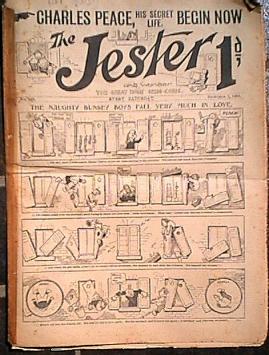 |
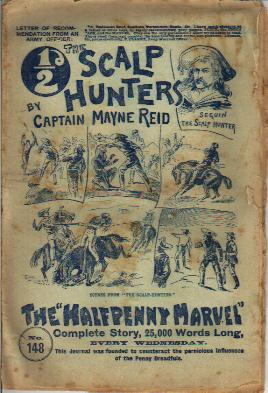 |
The 'Halfpenny Marvel' To the left is #148 of the
'Halfpenny Marvel'. (September, 1st, 1896) To
quote from the cover blurb: 'This journal was
founded to counteract the pernicious influences
of the Penny Dreadfuls'. A complete story, 25,000
words long. This issue, 16 pages plus covers
which were blank inside; strange indeed that
advertising wasn't placed thereon. The main story
ran to page 15 where a short story 'Paying the
Penalty' filled the page. Page 16 was the
editorial: The Editor Speaks', signed by
'Pimple', 'Chief Orfis-boy to the Marvel'! The
rear page was a full page ad to 'Comic Cuts', the
colour comic paper.
The cover includes
a letter of recommendation.
"31 Esslemont Road, Southsea, Portsmouth,
Hants. - Sir - I have much pleasure, as a father
of three boys, in highly recommending your
papers, PLUCK, the UNION JACK, and the MARVEL.
They are the only periodicals I allow my children
to read. I have read them, and consider the tone
healthy and moral, and patriotic. I remain, Sir,
yours obediently, F. CLARKE, Army Warrant
Officer."
|
| 'PLUCK' - Spearing, P.C. Having
read some excellent Philip McCutchan seafaring
novels (see the reviewx.html page) I retrieved
several more cartons from storage containing more
of Tom Ebbage's story paper collection. Among the
piles of The Popular and two bound volumes of
same, 1920 and 1921, were a number of single
issues of PLUCK.
Have you ever looked at a cover and known that
your were about to embark upon an outstanding
read? The issue of Pluck in question was Vol.10
new series no.320 dated 17th December 1910. The
title, 'Special Duty', st 'A Tale of Spearing
P.P.'. No doubt Steve will be able to tell us who
authored the story. My first thought was it was
written by Charles Hamilton, because Tom
generally only collected papers with Hamilton
stories. The tale involves a colliery strike and
is both exciting and believable, with remarkable
attention to details. Police Constable Spearing
is a relatively unconventional hero, and is
underwritten; things happen around him. His
character is not flushed out and for some reason
this works in the scheme of things. Usually such
stories pick one side or the other, the strikers
or management. The author here seems to be
scrupulously balanced in his views. The story has
a factual ring to it. Interesting that the 'P.C.'
is treated like an award like than a title,
namely 'Spearing, P.C.'. Perhaps due to it
harking back to the days when police were
respected?
|
Steve
I don't know if anyone ranks British
comics the same way as American comics, but I've always
considered the period between the wars to be The Golden
Age (this title was bestowed on the period by Denis
Gifford many times). I've always designated the war-time
period as The Dark Ages, and the birth of Eagle as the
starting point of The Silver Age, which extended through
to the next two decades. The early 1970s are last gasp of
the Silver Age as far as I'm concerned, with the
precursors to a more distinctly modern style comics
arriving in 1974 through 1977 (Warlord, Battle Picture
Weekly, Action), culminating in 2000AD which heralded,
for want of a better title The Modern Age.
That said, how modern can 2000AD be considered in the
year 2001? Is it well past its sell-by date as some
people think -- sales have fallen ever lower for years
and in 1999 dropped below 25,000 a week; Egmont Fleetway
didn't release figures for 2000, but they did sell the
title, which probably shows you how well it's doing.
The historic moment marked the end of the history of
the Amalgamated Press. There was a linear link between
2000AD and the first proper comic, Comic Cuts, founded in
1890. The Amalgamated Press became Fleetway Publications,
became part of IPC Magazines, became Fleetway Publishing,
became Egmont Fleetway. As 2000AD was the last of the
papers to be actually published by IPC before they
splintered their juvenile division -- selling off parts
of the rights to Robert Maxwell -- I've always considered
the nursery comics that have come out since to be the
product of a separate company. 2000AD was the old guard,
and as that's now produced by Egmont under license --
somebody else actually owns the title and it's edited
outside of the Egmont Fleetway building -- that, to my
mind, severs the link. It could be said that the A.P. era
(which encompasses a number of different name changes)
lasted 110 years. Things will never be the same again.
And the steady decline all started back in the
mid-sixties.
See Australian Book
Collectors for more
information on collecting storypapers. You may find these
pages of interest.
Children's
Annuals
Children's
Pocket Libraries
Clubs and
Magazines
|
bc |




